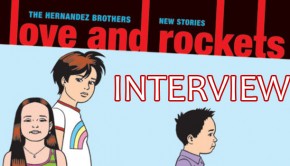The World of Los Bros Hernandez’s Love & Rockets
I have wanted to write about Love & Rockets for a long time, but have also found it difficult to figure out how to approach it. After all, how do you truly encapsulate one of the longest-running indie comics in the medium’s history, potentially only behind Dave Sim’s Cerebus?
Beyond its longevity, though, Love & Rockets is probably most notable for the power of synthesis utilized by its creators. Los Bros Hernandez (Jaime, Gilbert, and sometimes Mario) used their ’60s/’70s chicano/punk upbringing in southern California and their childhood interests (which included comic strips Archie and Little Lulu, wrestling movies, and a love of sci-fi and “low” culture) in a manner that made the world they constructed in their comics not only palpable, but also accessible to all regardless of race. Despite this, they never felt the need to compromise. Of the vast array of characters they wrote few, if any, could be described as caricatures.
Jaime, for his part, wrote specifically about life in California, using a group of punks and semi-low-lifers as his character base. His affection for them never wanes. At the center of this narrative is a woman named Maggie Chascarillo, who we watch evolve and grow from Issue 1. His Locas stories have been championed by LBGT organizations for their humanist depictions of bisexuality and lesbianism, which are such innate parts of their characters’ personalities that the narrative barely feels the need to address them directly, except with regard to their relationships. There also are lady wrestlers, vividly drawn punk shows, a lovingly imagined bombshell married to a billionaire who might be an alien.
Gilbert extends his narrative to an unnamed country in Central America, where there is a tiny village called Palomar. Typically described as magical realism, Gilbert’s narrative contains some of the more outrageous personalities and events in the comic’s run. He managed to process his idealized conceptions of women and his love of literature in a manner that led to the creation of some of the strongest female characters in comics. As a caveat, some have accused him of outright fetishizing his characters. While I wouldn’t necessarily go that far, it’s hard to argue that many of them are very sexual entities, which may be off-putting to some.
Considering the sheer amount and variety of characters Los Bros Hernandez wrote, it is unsurprising that the stories they are contained within run the gamut in both form and genre. They range from humanist explorations of memory (Wigwam Bam/Chester Square), to crime sagas (Poison River), to warm, tragic examinations of gang life and unrequited love (The Death of Speedy), even to horror stories that somehow tie together the previous twenty years of comics perfectly for one of the brothers (Ghost of Hoppers). Always, the brothers’ love for the medium prevents their experiments from ever coming across as simply that. It is a testament to their writing and drawing abilities that Love & Rockets is one of the most organic, warm, and enjoyable works in the medium.
To get started, click here. Los Bros publisher Fantagraphics put together a solid guide for navigating the many trade paperbacks that have thus far been released. Organized into arcs, these books separate the brother’s works in a manner that, while different from the manner in which they were originally published, could potentially be seen as the most accessible means of reading them. With the latest installment of their New Stories series hitting comic shops across the country next month, this is the perfect time to pick up Love & Rockets.



